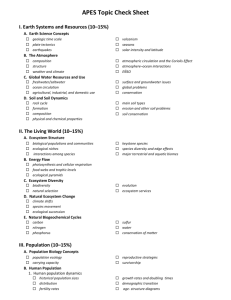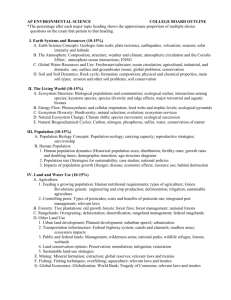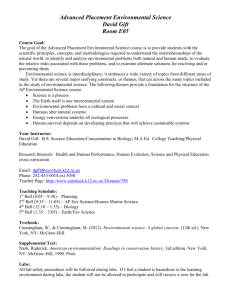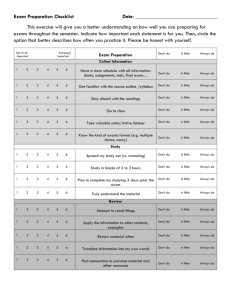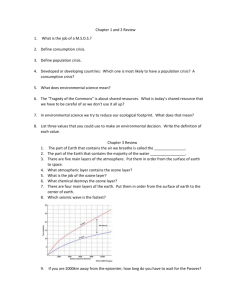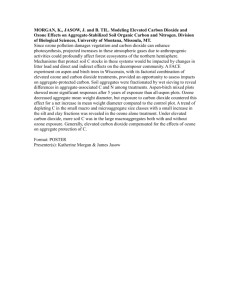AP environmental syllabus
advertisement
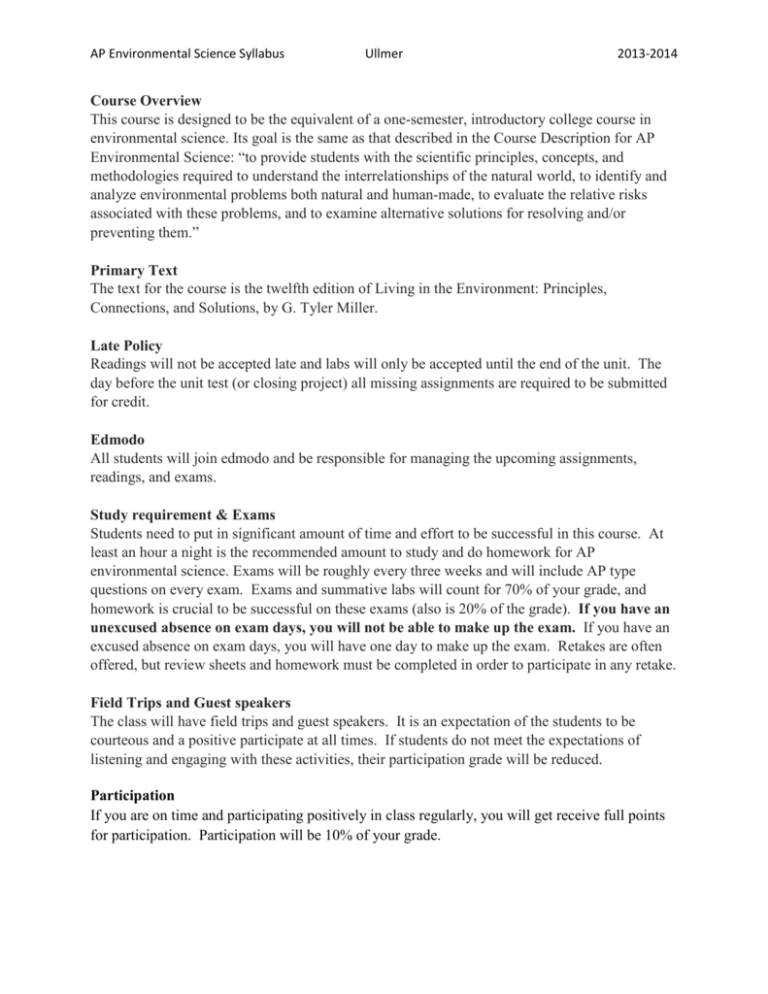
AP Environmental Science Syllabus Ullmer 2013-2014 Course Overview This course is designed to be the equivalent of a one-semester, introductory college course in environmental science. Its goal is the same as that described in the Course Description for AP Environmental Science: “to provide students with the scientific principles, concepts, and methodologies required to understand the interrelationships of the natural world, to identify and analyze environmental problems both natural and human-made, to evaluate the relative risks associated with these problems, and to examine alternative solutions for resolving and/or preventing them.” Primary Text The text for the course is the twelfth edition of Living in the Environment: Principles, Connections, and Solutions, by G. Tyler Miller. Late Policy Readings will not be accepted late and labs will only be accepted until the end of the unit. The day before the unit test (or closing project) all missing assignments are required to be submitted for credit. Edmodo All students will join edmodo and be responsible for managing the upcoming assignments, readings, and exams. Study requirement & Exams Students need to put in significant amount of time and effort to be successful in this course. At least an hour a night is the recommended amount to study and do homework for AP environmental science. Exams will be roughly every three weeks and will include AP type questions on every exam. Exams and summative labs will count for 70% of your grade, and homework is crucial to be successful on these exams (also is 20% of the grade). If you have an unexcused absence on exam days, you will not be able to make up the exam. If you have an excused absence on exam days, you will have one day to make up the exam. Retakes are often offered, but review sheets and homework must be completed in order to participate in any retake. Field Trips and Guest speakers The class will have field trips and guest speakers. It is an expectation of the students to be courteous and a positive participate at all times. If students do not meet the expectations of listening and engaging with these activities, their participation grade will be reduced. Participation If you are on time and participating positively in class regularly, you will get receive full points for participation. Participation will be 10% of your grade. AP Environmental Science Syllabus Ullmer 2013-2014 Extra help: I will be available almost every day after school if needed. Please let me know when help is needed so I can make sure I am available. If after school help doesn’t work, I can also meet with students during lunch or before school. AP exam This test is not a requirement of the course but is strongly encouraged. There are scholarships to help with the cost if you have free or reduced lunch. The test will be May 5, 2014 starting at 8 am. After the exam, the class will focus on long term, student designed experiments. I. A. B. C. D. II. Earth Systems and Resources (10%–15%) Earth Science Concepts (Geologic time scale; plate tectonics, earthquakes, volcanism; seasons; solar intensity and latitude) The Atmosphere (Composition; structure; weather and climate; atmospheric circulation and the Coriolis effect; atmosphere-ocean interactions; ENSO) Global Water Resources and Use (Freshwater/saltwater; ocean circulation; agricultural, industrial, and domestic use; surface and groundwater issues; global problems; conservation) Soil and Soil Dynamics (Rock cycle; formation; composition; physical and chemical properties; main soil types; erosion and other soil problems; soil conservation) The Living World (10%–15%) A. Ecosystem Structure (Biological populations and communities; ecological niches; interactions among species; keystone species; species diversity and edge effects; major terrestrial and aquatic biomes) B. Energy Flow (Photosynthesis & cellular respiration; food webs and trophic levels; ecological pyramids) C. Ecosystem Diversity (Biodiversity; natural selection; evolution; ecosystem services) D. Natural Ecosystem Change (Climate shifts; species movement; ecological succession) E. Natural Biogeochemical Cycles (Carbon, nitrogen, phosphorus, sulfur, water, conservation of matter) III. Population (10%–15%) A. Population Biology Concepts (Population ecology; carrying capacity; reproductive strategies; survivorship) B. Human Population IV. Land and Water Use (10%–15%) A. Agriculture B. Forestry (Tree plantations; old growth forests; forest fires; forest management; national forests) C. Rangelands(Overgrazing; deforestation; desertification; rangeland management; federal rangelands) D. Mining (Mineral formation; extraction; global reserves; relevant laws and treaties) AP Environmental Science Syllabus E. F. V. VI. VII. Ullmer 2013-2014 Fishing (Fishing techniques; overfishing; aquaculture; relevant laws and treaties) Global Economics (Globalization; World Bank; Tragedy of the Commons; relevant laws and treaties) Energy Resources and Consumption (10%–15%) A. Energy Concepts (Energy forms; power; units; conversions; Laws of Thermodynamics) B. Energy Consumption C. Fossil Fuel Resources and Use (Formation of coal, oil, and natural gas; extraction/purification methods; world reserves and global demand; synfuels; environmental advantages/disadvantages of sources) D. Nuclear Energy (Nuclear fission/fusion process; nuclear fuel; electricity production; nuclear reactor types; environmental advantages/disadvantages; safety issues; radiation and human health; radioactive wastes) E. Hydroelectric Power (Dams; flood control; salmon; silting; other impacts) F. Energy Conservation (Energy efficiency; CAFE standards; hybrid electric vehicles; mass transit) G. Renewable Energy (Solar energy; solar electricity; hydrogen fuel cells; biomass; wind energy; small-scale hydroelectric; ocean waves and tidal energy; geothermal; environmental advantages/disadvantages) Pollution (25%–30%) A. Pollution Types B. Impacts on the Environment and Human Health C. Economic Impacts (Cost-benefit analysis; externalities; marginal costs; sustainability) Global Change (10%–15%) A. Stratospheric Ozone (Formation of stratospheric ozone; ultraviolet radiation; causes of ozone depletion; effects of ozone depletion; strategies for reducing ozone depletion; relevant laws and treaties) B. Global Warming (Greenhouse gases and the greenhouse effect; impacts and consequences of global warming; reducing climate change; relevant laws and treaties) C. Loss of Biodiversity The exam will be on all of the material above and we will spend the couple weeks before the test reviewing, but it is CRUCIAL that you study throughout the year, not just the weeks prior to the test. The first week we will be covering habits to be successful at studying and organizing, but you will need to put in a great deal of effort. AP Environmental Science Syllabus Ullmer Name: Date: 2013-2014 Period: For a subject this strenuous, it is important to have short and long term goals. Below you will be making a long term goal and a short term goal. You will need to explain what it is, how you will reach it, and what support you need from me to be successful. Keep in mind to set a SPECIFIC, MEASUREABLE & ATTAINABLE goal that can be completed this year. 1. Long term goal: 2. How will you reach this goal? 3. What kind of support do you need to reach this goal (from me, your classmates, or your family)? 4. Short Term goal: 5. How will you reach this goal? 6. What kind of support do you need to reach this goal (from me, your classmates, or your family)? Parent Signature: __________________________ Best way to contact parent:______________ Preferred Language: ________________________
